ABSTRACT
With increased average air temperature, there is an increase in water vapour from a water surface. Between 2020 and 2022, evaporation from the water surface was observed with a floating evaporimeter at Vavřinecký pond in the Central Bohemian region. A floating evaporimeter monitors evaporation from the water surface along with basic meteorological quantities directly on the surface of the water reservoir, so its results should be more accurate than calculations based on data from nearby meteorological stations. The results show that in all three years evaporation exceeded precipitation by more than 100 mm between April and September. However, the issue of the influence of small water reservoirs on the hydrological balance is a very complex topic, where the assessment of negative and positive effects is not always black and white and requires detailed investigation.
INTRODUCTION
In the Czech Republic, average air temperature has been increasing in recent decades; over the past 60 years it has risen by more than 2 °C [1]. As the temperature increases, there is increased water evaporation from all surfaces of the Czech landscape, whether they are fields, forests, or water body. With stable balance, the loss of water through evaporation is compensated by precipitation totals; however, precipitation totals in the Czech Republic do not change much and remain (with various fluctuations) at the same level. Therefore, within the Czech Republic in areas with lower long-term precipitation totals (e.g. southern to central Moravia, Polabí, Poohří, the lower reaches of the Vltava), there is an increase in the negative difference between precipitation and evaporation. In these areas, total evaporation exceeds precipitation, and therefore they are in deficit in the long term.
In recent years, efforts have been made in the Czech Republic to propose and adopt adaptation measures that would support water retention in the landscape and reduce the overall water deficit. One of the discussed measures is the construction or renovation of small water reservoirs (SWR). According to ČSN 75 2410, these are reservoirs with a maximum depth of 9 m and a controllable volume of up to 2 million m3 [2]. SWRs have the potential to improve the flow below the dam in the dry season, and raising the groundwater level around the reservoir can also be beneficial. However, the impacts on the hydrological balance can also be negative, especially due to inappropriate selection of SWR function or their location within the Czech Republic. If there is insufficient inflow into an SWR and an area is selected with a long-term negative moisture balance, there will be excessive water evaporation, and the effect on the watercourse hydrological balance may thus be negative.
It is possible to calculate water losses by evaporation for specific SWR; however, more accurate data can be obtained by direct monitoring using an evaporimeter. TGM WRI has been dealing with direct evaporation monitoring since the 1950s [3]. In recent years, floating evaporimeters have been used to determine evaporation from water bodies; they are placed directly on the their surface, and thus can most precisely measure the meteorological conditions in a reservoir.
This article describes the results of evaporation measurement with a floating evaporimeter from the Vavřinecký pond water surface between 2020 and 2023 and its effect on the overall hydrological balance. In the conclusion, the pros and cons are discussed of using SWR as an adaptation measure supporting water retention in the landscape.
METHODOLOGY
Project „The influence of small water reservoirs on the groundwater level and hydrological balance with emphasis on dry periods“ (TITSMZP809)
The effect of evaporation from the water surface on the overall SWR hydrological balance was addressed between 2019 and 2022 within the programme of the Technology Agency of the Czech Republic (TA CR) Beta2 „The influence of small water reservoirs on the groundwater level and hydrological balance with emphasis on dry periods“ for the Ministry of the Environment (MoE). The main goal of the project was to assess the impact of SWR on the hydrological balance and its components at different spatial scales. The analysis was carried out in the SWR vicinity, in source catchments, and in catchments with systems of ponds and SWR. Hydrological balance was mainly assessed with regard to the influence of SWR on groundwater level, evaporation, and runoff. The activities were based on direct monitoring of selected hydrological quantities at the SWR, from analyses of the SWR vicinity through remote sensing data, estimation of the components of the hydrological balance by hydrological models together with a description of uncertainties, estimation of the physical-geographical characteristics of the SWR and affected basins, and from a regional analysis of the SWR characteristics [4].
Project „Water centre“ (SS02030027)
After the completion of the above-mentioned project, the research on direct monitoring of evaporation from the water surface at Vavřinecký pond was transferred to the work package WP3 „Adaptation measures on surface water and groundwater in deficit areas“, which is part of the research project SS02030027 „Water systems and water management in the Czech Republic in conditions of climate change (Water Centre)“ addressed within the Programme of applied research, experimental development and innovation in the field of the environment – Environment for life (Sub-programme 3 – Long-term environmental and climate perspectives) administered by the TA CR. The work package aims to assess possible adaptation measures for the deficit areas of the Czech Republic with regard to expected climate change scenarios. The investigated possible adaptation measures include water transfer, artificial infiltration, protection and support of groundwater sources, change in handling or increase of storage space of existing water/dry reservoirs, construction or restoration of SWR, support of natural infiltration through water retention in the landscape, and establishing protected sites for surface water accumulation. Accurate determination of water surface evaporation plays a role in designing or restoring SWR as an adaptation measure.
Vavřinecký pond
Vavřinecký pond is located in Central Bohemia upstream of the Výrovka (49.4 river km), about 3 km north of Uhlířské Janovice in the Kutná Hora district. With a surface area of about 71 ha and a volume of over 1 million m3, it is one of the largest SWR in Central Bohemia as well as the whole of the Czech Republic. It is fed by the Výrovka stream flowing from Uhlířské Janovice and the Ostašovský stream flowing from the southwest. The catchment area for the dam is 60 km2.
The site is located in the hydrogeological district of 6531 Kutná Hora crystalline basement. It is a typical environment of a hydrogeological massif with occurrence of fissure-permeable rocks. Precipitation infiltration occurs almost on the whole area, with the exception of areas with loess, poorly permeable rocks, where infiltration is very limited. Natural sources of groundwater are below average; values of specific underground runoff are given by Krásný et al. [5] around 1.5–2 l/s/km2, while the CGS balance calculations from 2006 give a value of 2.19 l/s/km2, which corresponds to infiltration at the level of roughly 8 % of total precipitation. Long-term more recent values of natural resources for 1981–2019 are given by Kašpárek et al. [6], whose calculations based on hydrological methods for hydrogeological region (HGR) 6531 correspond to a value of 1.5 l/s/km2; therefore, in the given HGR, there is a reduction of natural resources compared to older data, mainly due to the dry period 2014–2019.
Floating evaporimeter
An evaporimeter floating on a water surface can best simulate the meteorological conditions of a given water reservoir. It measures water temperature precisely compared to classic field evaporimeters, in which the water heat up faster in the spring and cool down faster in the autumn. Due to their large volume, water bodies have a certain inertia, thanks to which the temperature is more constant than in the measuring vessel itself. In the same way, the monitoring of evaporation directly on the water surface is more representative with regard to other conditions influencing this process, such as insolation and, above all, wind speed.
The floating evaporimeter used on the Vavřinecký pond (Fig. 1) consists of a supporting structure including floats and breakwaters, which includes a measuring vessel with a diameter of 620 mm. The device is powered by a battery charged by 2 solar panels (20W each). The container is equipped with a two-way pump that fills/drains water into/out of the evaporation measurement container in the event of a level change from the reference value by 5 cm.
Sensor equipment:
- H7-G-TA4-NZ – universal multi-channel monitoring unit with GSM/GPRS module FIEDLER
- Accurate evaporimeter level sensor, range 0–400 mm
- RVT13/RK – relative air humidity and air temperature sensor
- WD360 – wind direction sensor
- WS103 – all-metal anemometer
- PT100-KP – water temperature sensor, four-wire connection
- RDH11 – rain detector with controlled heating
- NR LITE2 – Kipp & Zonen Net Radiometer
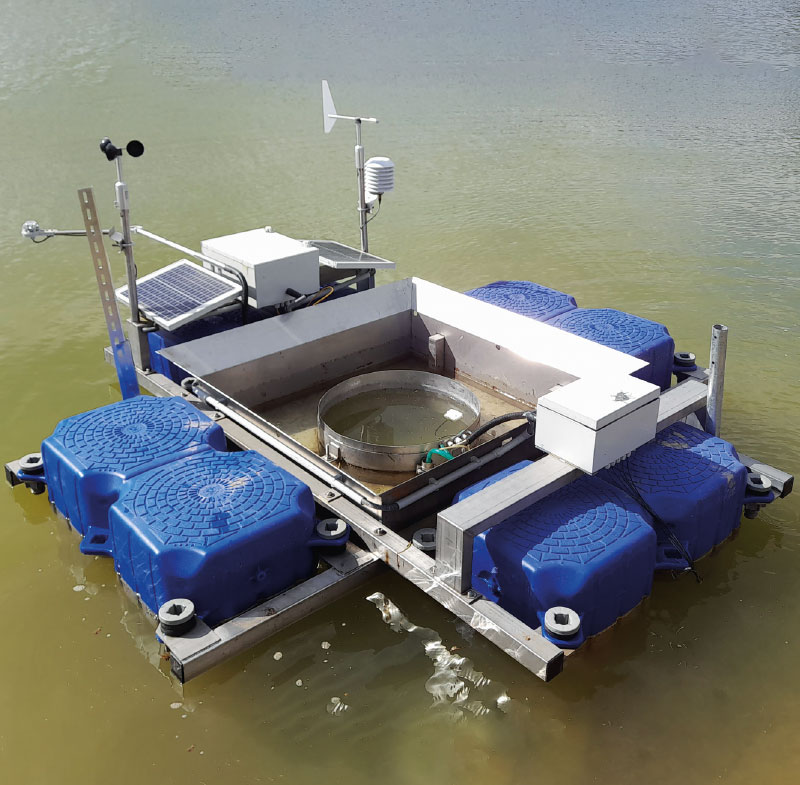
Fig. 1. Floating evaporimeter (FIEDLER)
DATA
Data is recorded at 10-minute intervals and sent to the server 3 times a day (at 1:00, 7:00, and 19:00) based on GSM data transmission. Evaporation and precipitation are measured on the basis of a 1-minute recording of the water level in the evaporative container in combination with a rain detector (in the case of rain detection, the level increase is caused by precipitation) and information about water intake/discharge into/out of the container. Average daily values of meteorological quantities are calculated as an average of 10-minute measurements on a given day. Evaporation and precipitation values are derived from 1-minute records.
Monitored meteorological quantities – evaporation [mm], precipitation [mm], solar radiation [W/m2], air temperature [°C], water temperature in the evaporimeter [°C], water temperature at depths 0.5–1–1.5–2–2.5 m [°C], wind speed [m/s], instantaneous wind speed [m/s], wind direction [0–360°], relative humidity [%].
Meteorological data was recorded by a floating evaporimeter; data from the CHMI measurement network from station P3STAN01 Vavřinec, Žíšov was used for verification. The gauging stations at the inflow and outflow (Fig. 2) were established as part of the TITSMZP809 project in 2019 and record the water level at the tributary – Ostašovský stream, Výrovka, and the outflow – Výrovka below the dam of Vavřinecký rybník in a minute step. As part of the project, shallow (depth up to 9 m) monitoring wells were established to monitor the groundwater level in the vicinity of the pond (50–300 m).
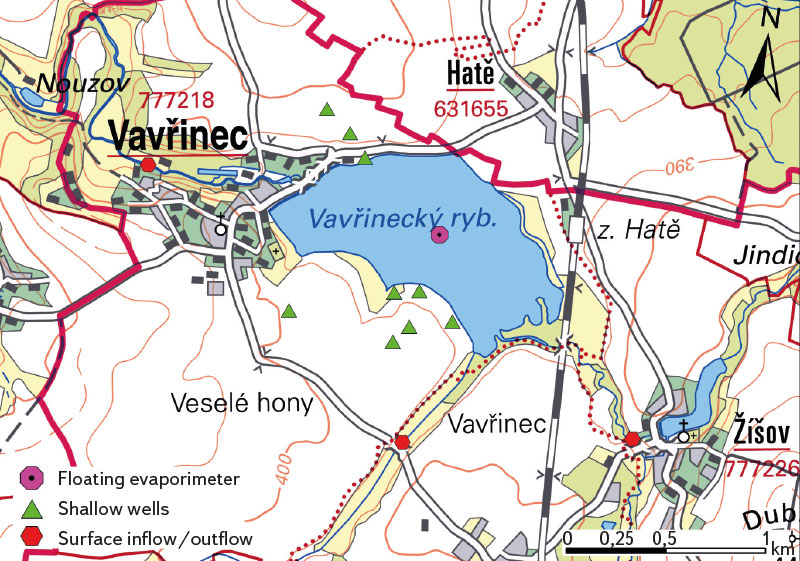
Fig. 2. Monitoring sensor location at Vavřinecký pond
RESULTS
In the measuring season from 1st April to 30th September 2022, total evaporation from the water surface was measured at 678.4 mm, while precipitation total was 582.4 mm. Average air temperature was 15.81 °C. The changes in air temperature, solar radiation, evaporation from the water surface, and precipitation is shown in the graphs in Figs. 3 and 4.
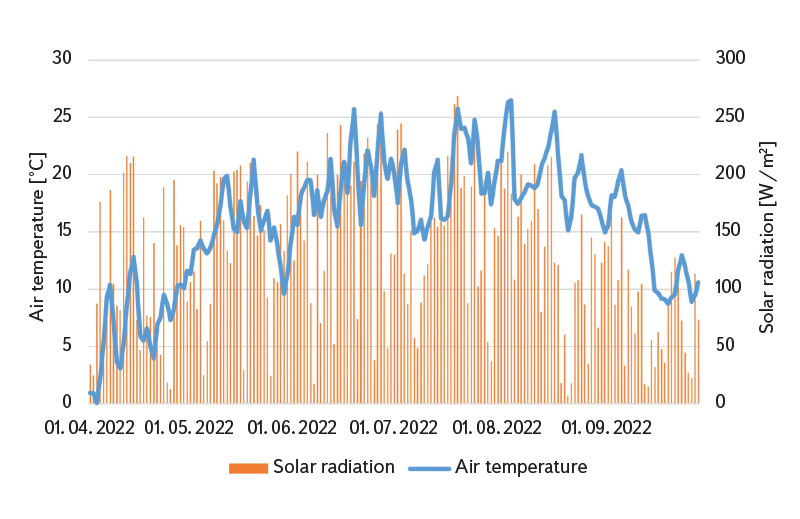
Fig. 3. Air temperature and solar radiation at Vavřinecký pond, 1st April 2022 – 30th September 2022
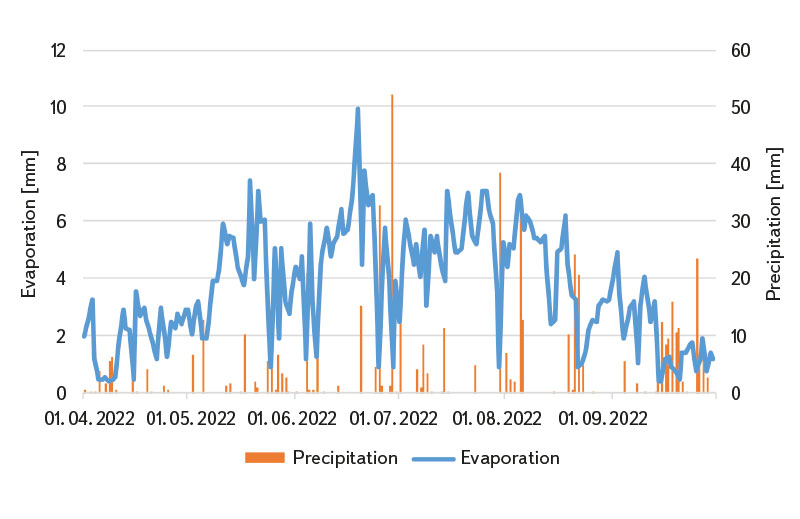
Fig. 4. Water surface evaporation and precipitation totals at Vavřinecký pond, 1st April 2022 – 30th September 2022
A comparison of total evaporation and precipitation in the last three years, when the floating evaporimeter was used, is shown in Tab. 1 together with data on the difference between precipitation and evaporation. The representation of evaporation in mm and at the same time in m3 in a daily step between 2019 and 2022 is shown in Fig. 5. The measured data clearly illustrate the fact that the water area of 71 ha means a significant loss of water from the watercourse in the summer months precisely due to evaporation. Every millimetre of vapour means a loss of 710 m3 of water. With an average daily evaporation of 3.7 mm in 2022, this represents an average daily water loss of 2,627 m3. The highest daily evaporation over the past three years was measured at Vavřinecký pond on 19th June 2022, namely 10 mm, which means a daily loss of water due to evaporation from the surface of 7,100 m3 in a single day. It should be mentioned that the change in surface area during water loss, which is negligible for losses of several centimetres, was not taken into account.
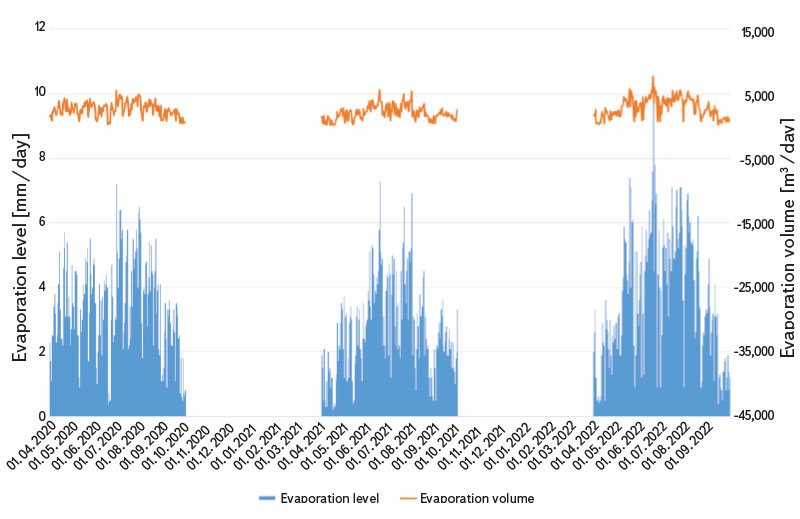
Fig. 5. Water surface evaporation at Vavřinecký pond, 1st April 2020 – 30th September 2022
Tab. 1. Comparison of water level evaporation and precipitation in 2020–2022 (April–October)

Fig. 6 shows a comparison of daily evaporation with current outflow from the pond and also with the value of average long-term outflow Qa = 0.3 m3/s and with the value of Minimal Ecological Flow (MEF) = 0.047 m3/s. In 2020, there was one case where the current outflow from the pond decreased below the value of the minimum residual flow. This situation occurred at the end of the season (in September), when precipitation totals and inflow into the reservoir were missing. The outflow was increased by water supply in the pond. In 2022, several days were recorded when evaporation from the water surface exceeded the value of minimum residual flow, and even the current value of outflow from the pond. This is best observed around 19th June 2022, when the water vapour was extreme.
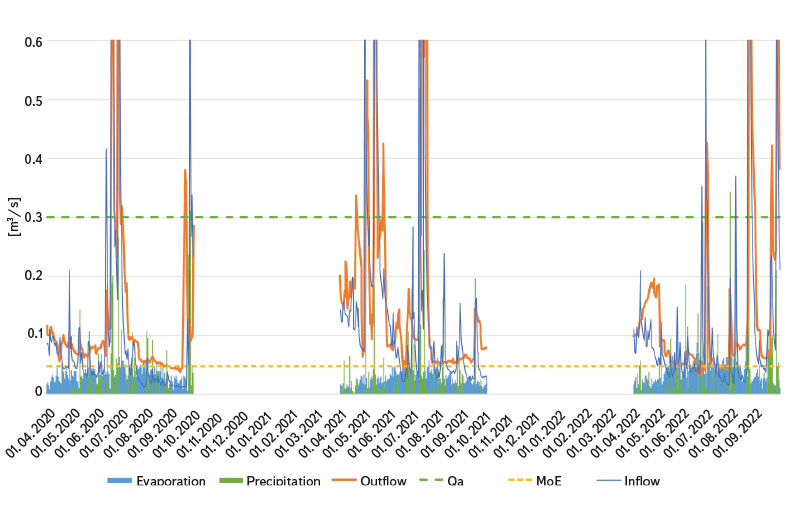
Fig. 6. Volume of water level evaporation compared to the precipitation, inflow and outflow characteristics at Vavřinecký pond, 1st April 2020 – 30th September 2022
CONCLUSION
Water surface evaporation is an important factor affecting the hydrological balance of a basin. Vavřinecký pond is a reservoir with a relatively large water surface area, which increases loss of water through evaporation and, during dry periods, a situation can arise when the influence of evaporation negatively affects the hydrological balance. During the monitored period, from April to September, total evaporation from the water surface ranged from 500 to 680 mm, with precipitation from 400 to 580 mm. In 2020, the water surface evaporation was higher then precipitation by 150 mm, and by 100 mm in 2021 and 2022; in terms of water volume, that is more than 70,000 m3 of water.
During the monitoring, only exceptionally did the values of the outflow from the pond decreased below the value of the minimum residual flow. Outflow was replenished in periods of low water at the expense of water supply in the pond. In 2022, there were also individual cases of water surface evaporation being greater than outflow from the pond.
This paper summarizes monitored evaporation data obtained by monitoring with a floating evaporimeter, placed on the surface of Vavřinecký pond from 2020 to 2022. Floating evaporimeters can more accurately monitor conditions on water bodies, in particular water temperature, solar radiation, and wind speed. Evaporation from the water surface is a negative factor from the point of view of watercourse balance within the hydrological balance. However, only on the basis of evaluation of the amount of precipitation and evaporation, it cannot be claimed that SWR have a negative impact on their surroundings. The SWR influence on the hydrological regime is very complex, as well as the influence of SWR through individual hydrological processes. Although it negatively affects the watercourse balance, water loss by evaporation also has a positive effect in the form of cooling the air due to the effect of energy consumed for the change in the state of matter during evaporation, which results in a positive influence on the microclimate. Undoubtedly, the increase in underground water reserves due to backwater in reservoirs can be considered a positive local influence of SWR. Last but not least, it is necessary to mention the possibility of the transformation of flood waves during significant rainfall-runoff events.
Positive and negative effects of SWR on the hydrological regime are described in the summary report of the project TITSMZP809 [4]. As the research carried out within the project shows, SWR influence the regime of both surface and sub-surface waters. The construction of SWR is often seen as a possible element of protection against the impacts of climate change; however, it is important to remember that water management elements affect different processes in different ways, both positively and negatively. Therefore, when restoring or proposing new SWRs, all possible impacts should be properly assessed. In terms of the effect of evaporation, the location of SWR within the Czech Republic in areas with a stable precipitation-evaporation balance is important, and the function of an SWR is also important. The methodological procedure for assessing the impacts of SWR on the hydrological balance and water resources deals with the procedure for designing or restoring SWR [7].
Acknowledgements
This paper was created as part of the projects TITSMZP809 “The influence of small water reservoirs on the groundwater level and hydrological balance with emphasis on dry periods” and “Water systems and water management in the Czech Republic under conditions of climate change (Water Centre)” financed by the Technological Agency of the Czech Republic.
The authors thank the employees of Rybářství Chlumec for their willingness and cooperation in monitoring the Vavřinecký pond with a floating evaporimeter.
This paper was presented at the Rybníky 2023 conference on 15th June 2023.
This article was translated on basis of Czech peer-reviewed original by Environmental Translation Ltd.
